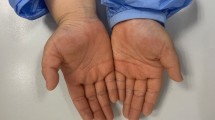Abstract
To understand anti-allergic effect of Curcuma aromatica (family Zingerberaceae), which inhibited passive cutenous anaphylaxis (PCA) reaction in preliminary study, we isolated its main constituents, curcumin, demethoxycurcumin and bisdemethoxycurcumin, and investigated their inhibitory effects against PCA reaction and scratching behavior. These curcuminoids inhibited the PCA reaction induced by the IgE-antigen complex (IAC) and the scratching behavior induced by compound 48/80. These curcuminoids also inhibited degranulation, protein expression of TNF-α and IL-4, and transcription factor NF-κB activation in IAC-induced RBL-2H3 cells. Of these curcuminoids, curcumin exhibited the most potent inhibition, followed by demethoxycurcumin and bisdemethoxycurcumin. These findings suggest that curcuminoids, particularly curcumin, can improve the symptoms of allergic diseases, such as anaphylaxis and itching.
Similar content being viewed by others
References
Antony, S. Kuttan, R., and Kuttan, G., Immunomodulatory activity of curcumin. Immunol. Invest., 28, 291–303 (1999).
Baroody, F. M. and Naclerio, R. M., Antiallergic effects of H1-receptor antagonists. Allergy, 55Suppl 64, 17–27 (2000).
Bielory, L., Complementary and alternative interventions in asthma, allergy, and immunology. Ann. Allergy Asthma Immunol., 93Suppl 1, S45–54 (2004).
Choo, M. K., Park, E. K., Han, M. J., and Kim, D. H., Antiallergic activity of ginseng and its ginsenosides. Planta Med., 69, 518–522 (2003).
Dairam, A., Limson, J. L., Watkin, s G. M., Antunes, E., and Daya, S., Curcuminoids, curcumin, and demethoxycurcumin reduce lead-induced memory deficits in male Wistar rats. J. Agric. Food Chem., 55, 1039–1044 (2007).
Kuttan, R., Sudheeran, P. C., and Josph, C. D., Turmeric and curcumin as topical agents in cancer therapy. Tumori, 73, 29–31 (1987).
Lee, H. S., Han, S. Y., Bae, E. A., Huh, C. S., Ahn, Y. T., Lee, J. H., and Kim, D. H., Lactic acid bacteria inhibit proinflammatory cytokine expression and bacterial glycosaminoglycan degradation activity in dextran sulfate sodiuminduced colitic mice. Int. Immunopharmacol., 8, 574–580 (2008).
Matsuda, H., Tewtrakul, S., Morikawa, T., Nakamura, A., and Yoshikawa, M., Anti-allergic principles from Thai zedoary: Structural requirements of curcuminoids for inhibition of degranulation and effect on the release of TNF-alpha and IL-4 in RBL-2H3 cells. Bioorg. Med. Chem., 12, 5891–5898 (2004).
Mitre E. and Nutman T. B., Basophils, basophilia and helminth infections. Chem. Immunol. Allergy, 90, 141–156 (2006).
Ozaki, Y., Antiinflammatory effect of Curcuma xanthorrhiza Roxb, and its active principles. Chem. Pharm. Bull., 38, 1045–1048 (1990).
Ram, A., Das, M., and Ghosh, B., Curcumin attenuates allergen-induced airway hyperresponsiveness in sensitized guinea pigs. Biol. Pharm. Bull., 26, 1021–1024 (2003).
Ruhlmann, A., Nordheim, A., Effects of the immunosuppressive drugs CsA and FK506 on intracellular signalling and gene regulation. Immunobiology, 198, 192–206 (1997).
Schafer-Korting, M., Schmid, M. H., and Korting, H. C., Topical glucocorticoids with improved risk-benefit ratio. Rationale of a new concept. Drug Saf., 14, 375–385 (1996).
Shishodia, S., Singh, T., and Chaturvedi, M. M., Modulation of transcription factors by curcumin. Adv. Exp. Med. Biol., 595, 127–148 (2007).
Simons, F. E., The antiallergic effects of antihistamines (H1-receptor antagonists). J. Allergy Clin. Immunol., 90, 705–715 (1992).
Sugimoto, Y., Umakoshi, K., Nojiri, N., and Kamei, C., Effects of histamine H1 receptor antagonists on compound 48/80-induced scratching behavior in mice. Eur. J. Pharmacol., 351, 1–5 (1998).
Stevens, R. L. and Austen, K. F., Recent advances in the cellular and molecular biology of mast cells. Immunol. Today, 10, 381–386 (1989).
Wuthrich, B., Epidemiology of the allergic diseases: are they really on the increase? Int. Arch. Allergy Appl. Immunol., 90Suppl. 1, 3–10 (1989).
Author information
Authors and Affiliations
Corresponding author
Rights and permissions
About this article
Cite this article
Trinh, HT., Bae, EA., Lee, J.J. et al. Inhibitory effects of curcuminoids on passive cutaneous anaphylaxis reaction and scratching behavior in mice. Arch. Pharm. Res. 32, 1783–1787 (2009). https://doi.org/10.1007/s12272-009-2217-7
Received:
Revised:
Accepted:
Published:
Issue Date:
DOI: https://doi.org/10.1007/s12272-009-2217-7




